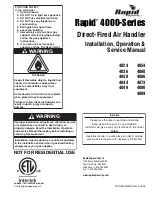
49
E-Coated Coil Cleaning
Documented routine cleaning of e-coated
coils is required to maintain coating
warranty coverage.
Surface loaded fibers or dirt should be
removed prior to water rinse to prevent
restriction of airflow. If unable to back wash
the side of the coil opposite of the coils
entering air side, then surface loaded fibers
or dirt should be removed with a vacuum
cleaner. If a vacuum cleaner is not available,
a
soft non-metallic
bristle brush may be
used. In either case, the tool should be
applied in the direction of the fins. Coil
surfaces can be easily damaged (fin edges
bent over) if the tool is applied across the
fins.
Use of a water stream, such as a garden
hose, against a surface loaded coil will drive
the fibers and dirt into the coil. This will
make cleaning efforts more difficult. Surface
loaded fibers must be completely removed
prior to using low velocity clean water rinse.
A
monthly
clean
water
rinse
is
recommended for coils that are applied in
coastal or industrial environments to help to
remove chlorides, dirt, and debris. It is very
important
when
rinsing,
that
water
temperature is less than 130°F and pressure
is than 100 psig to avoid damaging the fin
edges. An elevated water temperature (not to
exceed 130°F) will reduce surface tension,
increasing the ability to remove chlorides
and dirt.
Quarterly cleaning is essential to extend
the life of an e-coated coil and is required
to maintain coating warranty coverage.
Coil cleaning shall be part of the unit’s
regularly
scheduled
maintenance
procedures. Failure to clean an
e-coated coil
will void the warranty and may result in
reduced efficiency and durability.
For routine quarterly cleaning, first clean the
coil
with
the
below
approved
coil
cleaner. After cleaning the coils with the
approved cleaning agent, use the approved
chloride remover to remove soluble salts and
revitalize the unit.
Recommended Coil Cleaner
The following cleaning agent, assuming it is
used in accordance with the manufacturer’s
directions on the container for proper mixing
and cleaning, has been approved for use on
e-coated coils to remove mold, mildew,
dust, soot, greasy residue, lint, and other
particulate:
Enviro-Coil Concentrate, Part Number H-
EC01.
Electric shock hazard. Shut off all
electrical power to the unit to avoid
shock hazard or injury from rotating
parts.
WARNING
Harsh chemicals, household bleach,
or acid cleaners should not be used
to clean outdoor or indoor e-coated
coils. These cleaners can be very
difficult to rinse out of the coil and
can accelerate corrosion and attack
the e-coating. If there is dirt below the
surface
of
the
coil,
use
the
recommended coil cleaners.
High velocity water from a pressure
washer or compressed air should
only be used at a very low pressure
to prevent fin and/or coil damages.
The force of the water or air jet may
bend the fin edges and increase
airside pressure drop. Reduced unit
performance
or
nuisance
unit
shutdowns may occur.
CAUTION
CAUTION
Summary of Contents for SA-023
Page 2: ......
Page 20: ...20 Figure 2 One Piece Single Unit Lifting Details ...
Page 21: ...21 Figure 3 Two Piece Single Unit Coil Section Lifting Details ...
Page 22: ...22 Figure 4 Two Piece Single Unit Fan Section Lifting Details ...
Page 23: ...23 Figure 5 One Piece Dual Unit Lifting Details ...
Page 24: ...24 Figure 6 Two Piece Dual Unit Coil Section Lifting Details ...
Page 25: ...25 Figure 7 Two Piece Dual Unit Fan Section Lifting Details ...
Page 28: ...28 Figure 10 Dual unit with splices after being bolted together ...
Page 63: ...63 ...






































